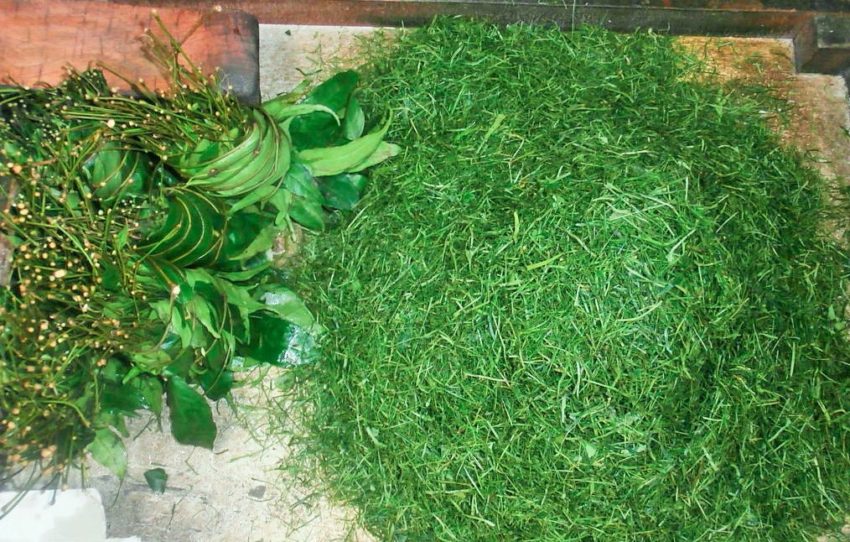- 이 주제는 비어 있습니다.
- 글쓴이글
- 4월 7, 2025 6:21 오전 #622823

Gnetum africanum, commonly known as Afang leaves, is a highly valued plant in many parts of West and Central Africa, particularly for its culinary uses.
The leaves of this plant are an essential ingredient in traditional dishes, particularly in the preparation of soups and stews. However, as demand for Afang leaves grows, concerns about its sustainability have emerged.
Ensuring the sustainable harvesting of Gnetum africanum is crucial for maintaining the health of the plant population and the ecosystems they thrive in. This article discusses the methods and practices involved in sustainably harvesting Gnetum africanum for culinary use.
1. Understanding the Ecological Importance of Gnetum Africum
Gnetum africanum is not just an important culinary plant, but also plays a significant role in its native ecosystems. It is a climbing vine found in tropical forests, where it contributes to the biodiversity and structure of the vegetation.
By providing food and shelter for various species of animals, the plant supports the overall ecological balance of the forest. Overharvesting of Afang leaves could disrupt local ecosystems, affecting both the plant’s population and the species dependent on it.
Understanding the ecological importance of Gnetum africanum is key to promoting sustainable harvesting practices that protect both the plant and its habitat.
2. The Impact of Overharvesting on Gnetum Africum Populations
Overharvesting of Gnetum africanum can lead to a decline in its population and threaten its long-term availability. This is particularly concerning in regions where Afang leaves are in high demand for traditional cuisines and medicinal purposes.
\If the leaves are harvested excessively, without giving the plant enough time to regenerate, it can result in the depletion of local populations. Additionally, unsustainable harvesting methods, such as the cutting of entire vines or the removal of too many leaves at once, can cause permanent damage to the plants, reducing their ability to reproduce and grow back.
It is therefore essential to understand and implement harvesting methods that allow for plant regeneration and population sustainability.
3. Methods for Sustainable Harvesting
To ensure sustainable harvesting of Gnetum africanum, there are several key practices that should be followed. One of the most important is selective harvesting, where only mature leaves are picked, leaving younger ones to grow and reproduce. This practice helps maintain the health of the plant and ensures that it continues to produce leaves for future harvests. Additionally, it is important to avoid cutting the vines completely, as this can kill the plant. Instead, harvesting should focus on removing leaves from different parts of the plant, allowing it to regenerate. Farmers and gatherers should also be educated about the importance of harvesting at the right times to prevent overexploitation and allow the plant to regenerate naturally.
4. Agroforestry and Cultivation of Gnetum Africum
Another strategy for sustainable harvesting of Gnetum africanum is its cultivation through agroforestry systems. Agroforestry, which involves the integration of trees and crops in a way that benefits both the environment and agriculture, provides an opportunity to cultivate Afang leaves without depleting wild populations.
By growing Gnetum africanum alongside other crops, farmers can reduce the pressure on wild plants while also creating a sustainable supply of leaves for culinary use. This practice also helps improve soil quality, increase biodiversity, and support ecosystem services, such as water regulation and soil erosion prevention.
Encouraging the cultivation of Gnetum africanum through agroforestry can provide a more sustainable and controlled source of Afang leaves, benefiting both local communities and the environment.
5. Community Involvement and Education for Sustainability
Sustainable harvesting practices cannot be fully effective without the involvement of local communities who rely on Gnetum africanum for their livelihoods. Community-based management and education programs are essential for promoting sustainable harvesting practices and ensuring that these practices are passed down through generations.
Local farmers, harvesters, and consumers should be educated on the importance of sustainable harvesting, the ecological impact of overexploitation, and the long-term benefits of maintaining healthy Gnetum africanum populations.
By involving the community in decision-making processes and providing incentives for sustainable practices, it is possible to create a culture of sustainability that benefits both people and the environment.
In conclusion, the sustainable harvesting of Gnetum africanum (Afang leaves) is essential for preserving both the plant’s population and the ecosystems it inhabits.
By implementing practices such as selective harvesting, promoting agroforestry, and involving local communities in sustainability efforts, it is possible to meet the growing demand for Afang leaves while ensuring the plant’s long-term survival.
Sustainable practices not only protect the plant but also support the livelihoods of those who depend on it for food and income.
As the demand for Gnetum africanum continues to rise, it is crucial to adopt responsible harvesting methods that balance human needs with environmental conservation, ensuring that future generations can continue to enjoy the benefits of this valuable plant.
Read Also: Domestication and Cultivation Potential of Afang Leaf
- 글쓴이글
- 답변은 로그인 후 가능합니다.

